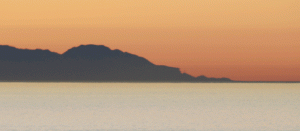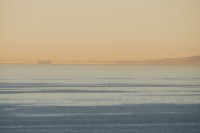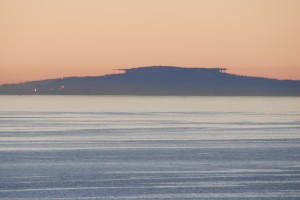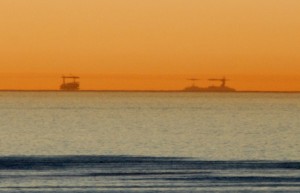Terrifying UFOs, or Fata Morgana Mirages?

An animation I made of the northern end of Santa Catalina Island. The lighter, lower contrast frames were later in the evening. CLICK TO WATCH THE ANIMATION.
One of the benefits of living on the coast is that I’m frequently treated to some amazing mirages out over the ocean. I took the accompanying photographs in February, which is when this phenomenon is most dramatic. It’s the coldest water of the year, with an average temperature of 57F. The average high air temperature is about 69F, and that warmer air is blown out to sea by onshore winds in the afternoon. It’s at this time, when the warmest air is out there around sunset, that the effect appears.
As you may know, mirages happen when light refracts where a layer of hot air meets a layer of cold air. Such layers have different indices of refraction, and the image you see (which has some vertical height to it) gets progressively refracted as it enters the temperature boundary at an angle. If you look directly at a distant object on the horizon, and your line of sight does not pass through any such boundaries, you see it. But you can also see it by looking above it (or below it), depending on whether your line of sight passes up (or down) through such a boundary. This means you can see the same thing twice.

Double horizon, stretched ship, horizon appears triplicated at the tip of land: normal, inverted, and normal again (click for a full size image)
The most familiar example is seeing the reflection of a patch of sky on the road ahead of you, so it looks like a shimmering lake. The road is much hotter than the air above it. Since you see the patch of sky below the actual sky, we call this an “inferior” mirage. Many mornings, the ocean — a great big heat sink — is warmer than the air immediately above it, similar to that hot road, and the horizon becomes an unstable wavy line. One thing is happening, and I’m not sure which: either patches of sky are being refracted down below the actual horizon, or patches of ocean are being refracted above the actual horizon. Since there are shifting winds and waves out there, this assemblage swaps around quite a bit, and the line of the horizon is highly unstable.
At sea in the late afternoon, as illustrated in the pictures I took here, you can see a reflection of an object on the horizon above its actual position. We can this a “superior” mirage. I am no expert in mirages, but my experience is that this happens (again) when the water is warmer than the air. Standing on shore it’s hard for me to know the air temperature and the water temperature way offshore, so I could easily be in error.

Palos Verdes, afflicted by mirage action. I can assure you Palos Verdes does not actually look like this.
If any of you out there are more knowledgeable than I about mirages, I would love some clarification. Professor Google states, almost universally, that superior mirages result when cold air is at the surface and there’s a layer of warm air above it, suggesting that the water is colder than the air, as in the summertime. However I observe these in the winter, the air temperature (which fluctuates a lot) can often be colder than the ocean temperature (which changes quite gradually). Are my observations of the temperatures out there wrong, or are these distinct mirages the result of more complicated layering?
Either way, the visual show is super duper nifty.


Hi Brian,
Thanks for explaining this phenomenon. I live on the inner shore of Cape Cod, right at the bend of the “elbow,” and we see this all the time. It’s a very cool illusion, but I was never clear on how to describe it optically. (By the way, I was one of your volunteers who shot video for “Here be Dragons.” THAT Mark O’Leary. Cheers!)
I don’t know about you, but I clearly see the Virgin Mary on the horizon.
Very interesting piece, great photos. When I was a student at Northwestern, my dorm room had a view of Lake Michigan. I would see superior mirages quite often in the springtime. It’s when warm air overlays cold water (and believe me, Lake Michigan stays cold most of the year!). Optically speaking, the superior and inferior mirages are opposite effects. The inferior mirage (warm highway, cooler air), you see light from above (the sky) refracted downward. The superior mirage (warm air, cooler water), you see what is below (typically objects beyond the horizon) lifter upward.